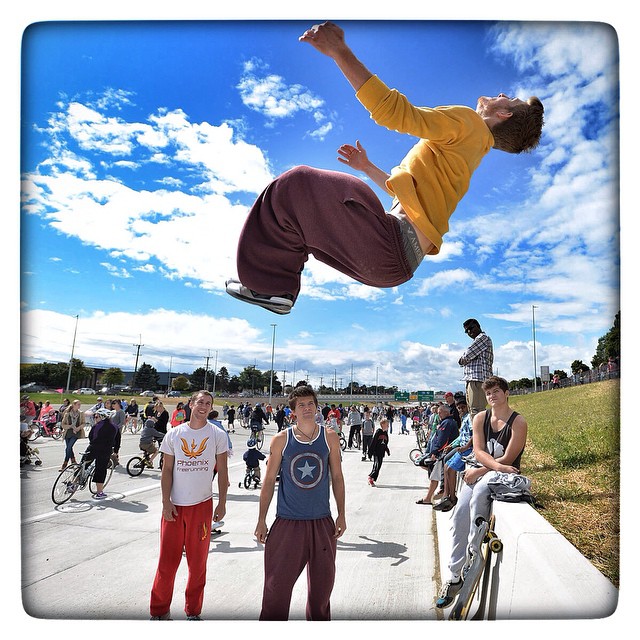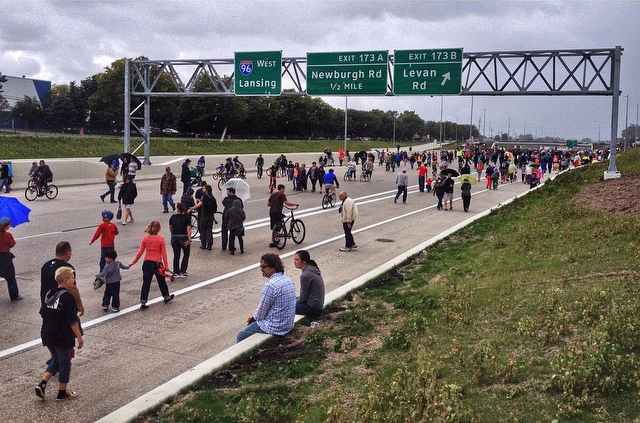I96. Image courtesy of @ishootmi.
"The long wait is finally over", says Ashlee Baracy, "Traffic is moving again on this stretch of I-96".
Baracy is referring to the recently completed (and ahead of schedule) road upgrade on Detroit's Interstate 96. The $148 million project is welcome news for drivers but is this 'improvement' a missed opportunity for a more liveable Detroit?
Around the world, roads and the way we view them, are changing. We're seeing the rise of community led initiatives that are converting roads into people places and Governments that are adopting progressive transportation policies to make roads safer and more comfortable.
These projects don't discriminate against modal choice but don't prioritise the car either. They find balance in meeting local and regional economic needs, moving products and people from 'A to B', while making the journey more enjoyable and improving micro experiences along the route.
The Complete Streets policy and design approach achieves this balance by improving road efficiencies and designing better environments for people and their communities. In a similar way but through a temporary activation, the Open Streets Project closes roads to automobile traffic and invites the public to explore the space, reclaiming it as a place for people not just the car.
I96. Image courtesy of @caitbug420.
On Sunday, 21 September 2014, this is what happened on the I-96. Governor Rick Snyder declared the freeway a Family Fun Day and invited the public to 'view' the upgrade. In total, more than 10,000 people took the opportunity to play on the newly completed 7 mile section with the public response catching people by surprise. "Sunday afternoon was a celebration, something we'd never really seen before. Thousands walked or biked on the reconstructed freeway which was obviously still closed to traffic" says Ashlee Baracy.
The day was a huge success. It was also a missed opportunity.
In many ways the 'fun day' highlighted other uses for the extensive (and now underutilised) car-based infrastructure that currently exists within the City itself but failed to connect these new uses with long term planning or strategy. Can we have fun and also plan a better City too?
In a City synonymous with the car, is it time for Detroit and its suburbs to build a new brand? A new image that reflects its people rather than its products? And if so, how can the Detroit landscape, in a rapidly changing world, be used to benefit the City rather than cause it harm?
"Detroit calls for more intimate exploration", says Joe Baur, "And there’s no better way to experience this iconic city once ruled by cars than on the saddle of a bike."
Baur in his article, ‘Cycling Detroit makes too much sense to ignore’, claims urban infrastructure previously focused on the American Dream and suburban culture could be adapted to produce a new urban paradigm. It's an interesting concept and one that is changing the very fabric of cities that have already adopted cycling as a serious transport option.
In Detroit there is also a move towards the return of the wheel (bicycle that is). Innovative companies like Shinola are now making more bespoke products (including bikes), the Tour de Troit is advocating for non-motorized infrastructure and the Slow Roll originally starting in Detroit, is now popping up around the Globe as new Slow Roll chapters emerge in Malmo and Berlin, just to name a few. Attracting over 3000 riders each week, the Slow Roll is a local success story and so too are these other projects reflecting a growing appreciation, recognition and need for a stronger bike culture in Detroit.
This is something the project team of I-96 should have considered during the upgrade. How can a city built from 20th Century values be adapted to suit 21st Century needs? Instead of manufacturing cars, could Detroit celebrate a new future, one with a strong vision to supply America and the world with bikes?
What are your thoughts? Should Detroit's Interstates be adapted for cycling and what culture change would this bring for a shrinking City limited only by possibilities?
I96. Image courtesy of @whalemap.


